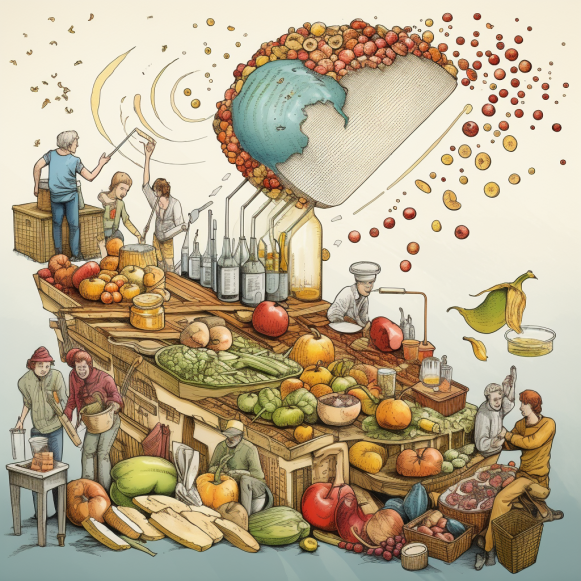JPMorgan: The world’s food supplies face a bleak future. These are the 3 biggest threats, and the companies best-positioned to tackle food insecurity.

- War in Ukraine, bad weather around the world, and export restrictions have hurt global food supply.
- JPMorgan reports on the state of the global food market, and the mounting disruptions.
- The firm also breaks down which stocks around the world will play key roles in the future of food.
Hurricanes in California are flooding the Southwest, forest fires in Canada are sending clouds of noxious smoke down the East Coast, and heat waves have hit nearly every state in between.
Extreme weather events are becoming more extreme and common, causing agricultural output all over the world to suffer. And those are just the obvious issues.
Man-made issues such as the Ukraine war, which has disrupted grain exports as well as key fertilizer ingredients such as nitrogen and phosphates, have taken a toll on global food production. Governments around the world have responded by stockpiling food supplies, reducing availability even further.
While it may appear that these aren’t issues that investors should be concerned about, the truth is that climate change and geopolitical tensions are putting more strain on the world’s food supply than ever before.
For many, the consequences are very real. According to a July 2023 UNICEF report, 2.4 billion people experienced moderate to severe food insecurity last year — nearly 30% of the global population.
Joyce Chang, JPMorgan’s Chair of Global Research, recently issued a note to clients warning that a global food crisis is closer than anyone expects. Investors must understand where the threats to the world’s food supply are coming from, what themes are emerging in this new reality, and how they should invest.
New threats to the world’s food supply
Chang highlighted three ongoing issues affecting the world’s food supply in her report: war, weather, and food weaponization. Chang, in particular, outlined three immediate issues that investors should be aware of.
“Three shocks—the collapse of the Black Sea Grain Initiative (BSGI), new rice export restrictions, and El Nio—tilt food prices to the upside,” she explained.
It is now widely acknowledged that the Ukrainian conflict has had far-reaching consequences, particularly in the agricultural sector. The Black Sea Grain Initiative (BSGI), in which Ukraine and Russia independently agreed to allow the export of grain and fertilizer products from Ukraine, had alleviated much of the pain.
However, Russia protested that its requirements were not met and has since terminated the agreement, causing Ukrainian exports to be disrupted and global grain inventories to fall.
“The collapse of the BSGI reflects the overall fundamental instability across the global food system,” Chang wrote. “The initiative played a critical role in Ukraine’s bulk agricultural exports, as well as farmers’ intentions to invest in crop production, which remains undiminished despite the conflict.”
Perhaps one unintended consequence of the Ukrainian conflict is a greater sense of urgency among governments around the world to secure their food supplies.
“Food and fertilizer export restrictions have become the’new normal’ since the start of the Russia/Ukraine war,” Chang wrote. She later added, “The International Food Policy Research Institute’s (IFPRI) COVID-19 Food Trade Policy Tracker reports that as of June 5, 2023, 20 countries had implemented 27 food export bans, and 10 had implemented 14 export limiting measures.”
One of the most devastating recent food supply restrictions is India’s decision to prohibit the export of non-Basmati white rice. As the world’s largest producer of this staple food, India’s ban has serious ramifications for millions of people worldwide, particularly in Africa and Asia.
While El Nio and Hurricane Hilary have received a lot of attention, Chang pointed out that India’s erratic monsoon season has also contributed to lower rice output than usual. As a result, “India has effectively banned export on about 20% of global rice exports,” Chang wrote, in addition to previous export restrictions.
In terms of weather, patterns such as El Nio could have a significant impact on food production. “El Nio is associated with upward pressure on global commodity prices, including a range of raw material prices in addition to food,” Chang writes for JPMorgan economists.
Chang predicted that El Nio conditions will only worsen throughout the rest of 2023, putting Latin American countries in particular at risk.
The combination of war, weather, and food weaponization has reduced the world’s food availability.
While the effects of these short-term issues on food supply may be mitigated, the long-term problems of increased demand will only worsen.
“By 2050, it is estimated that the world’s population will reach 10 billion, with food demand likely to rise by 50% from current levels,” Chang wrote.
How to invest in food security
So, what does this all mean for investors?
JPMorgan analysts believe that food prices will continue to rise at a rapid pace. According to Chang, agricultural commodity prices have risen 5% since June and are expected to rise another 8% before the end of the year.
El Nio, a Midwest drought, and geopolitics will exacerbate price increases in the short term, while the effects of the BSGI ending will be felt for the foreseeable future.
“Our Agriculture Commodities team sees the termination of BSGI as a more medium-term than short-term price risk, but we will stay long the agri complex via an index as our price forecasts sit above futures curves and markets are discounting supply side and geopolitical risks,” Chang wrote.
With more threats to the global food system than ever before, investors must understand how food insecurity will affect markets in the coming years.
To that end, JPMorgan analysts focused on several key geographical areas, determining not only the key food-investing themes for each, but also which stocks they believe will play important roles in ensuring food security in each market.
According to Chang, it is critical for ASEAN countries, in particular, to adapt to climate change and improve food security, because “growing populations and rising incomes will increase absolute demand for calories.”
Analysts at JPMorgan divided ASEAN food-related equities into three categories: farming efficiency, crop resilience, and food innovation, and offered investment suggestions for each.
JPMorgan is overweight on Indian automobile and farm equipment manufacturer Mahindra and Mahindra (MM IN), South Korean food conglomerate CJ Cheiljedang (097950 KS), and Chinese dairy producer Mengniu Dairy (2319 HK) in terms of farming efficiency. They also stated that Escorts Kubota, an Indian agricultural machinery manufacturer, will play a role in improving farming efficiency, though they are not bullish on the stock.
JPMorgan is bullish on LG Chem (051910 KS), South Korea’s largest chemical producer, when it comes to crop resilience. JPMorgan analysts like Philippine food and beverage maker Monde Nissin (MONDE PM) and Thailand-based seafood producer Thai Union (TU TB) in terms of food innovation.
JPMorgan analysts in Europe were looking for stocks that “are resilient to disruption from agricultural product/input end market, including fertilizer stocks,” Chang wrote. “Increased investment in agricultural products should lead to increased consumption of fertilizers,” she added. More secure food supply should benefit food retailers.”
JPMorgan analysts believe that the consumer staples companies listed below will be important to future food security in Europe: Jeronimo Martins SGPS SA (JMT PL), Tesco PLC (TSCO LN), J Sainsbury PLC (SBRY LN), Koninklijke Ahold Delhaize NV (AD NA), and Carrefour SA (CA FP). JPMorgan identified K+S AG (SDF GY), Yara International ASA (YAR NO), and OCI NV (OCI NA) as key materials manufacturers, as well as healthcare company Bayer AG (BAYN GR).
Finally, Chang identified two major themes to keep an eye on in the United States. To begin, she stated that JPMorgan analysts “favor food producers that can sustainably grow revenues at a faster pace than the industry average.”
JPMorgan’s top pick in this category is PepsiCo (PEP). PepsiCo, as one of the world’s largest snack companies, wields enormous power over food producers all over the world. According to Chang, PepsiCo has recognized that focusing on sustainable food practices will only benefit the company in the long run.
Another important theme is technological advancement and automation. With powerful technological advances boosting productivity and higher labor costs, food producers are heavily investing in automation. However, these investments in operations and R&D are costly, so companies that spend on technology while increasing revenue are the best stock picks.
Few companies can pull off this balancing act, but JPMorgan analysts are bullish on Hostess (TWNK) and Mondelez (MDLZ), primarily because both can grow revenue faster than competitors while making these critical investments.






